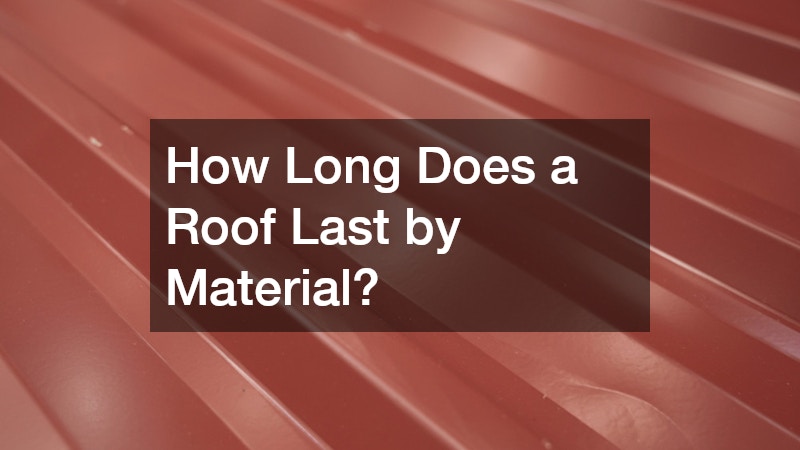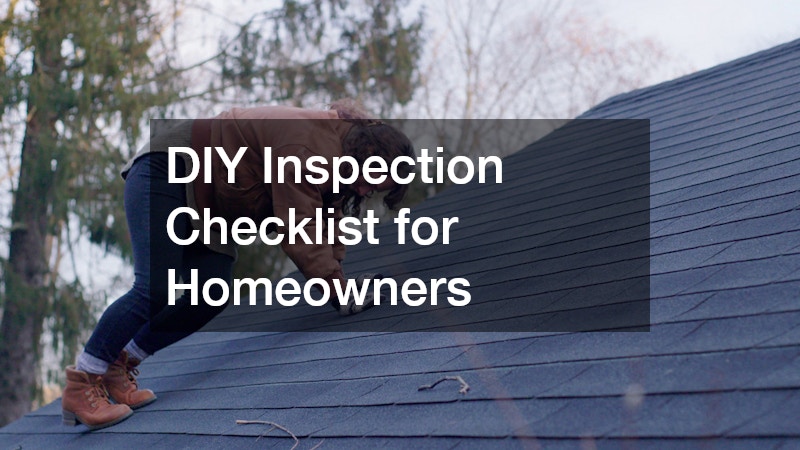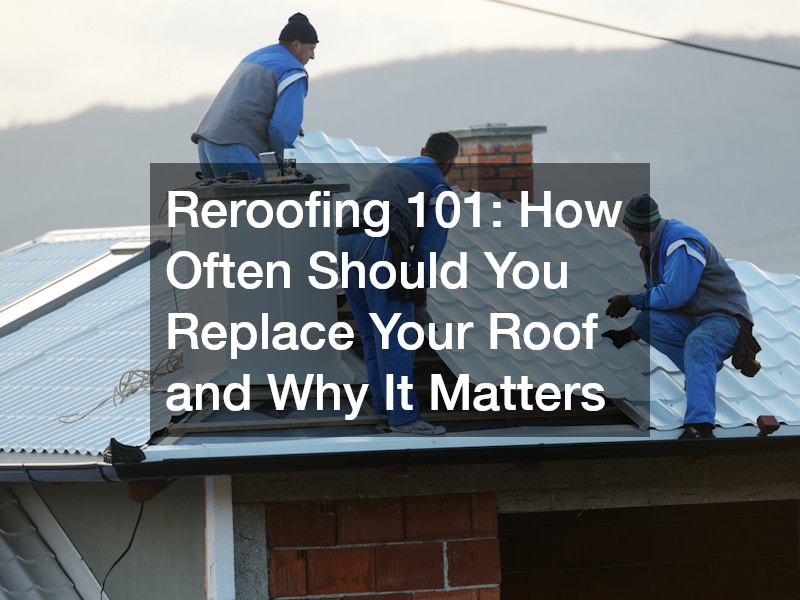
A strong and well-maintained roof is more than a shield—it stands as the first line of defense against the elements. For homeowners, knowing how often you should replace your roof can prevent water damage, energy loss, and costly emergency repairs. Overlooking the age or condition of your roof could jeopardize your home’s structural health and your family’s comfort.
This comprehensive article walks you through roof lifespans, warning signs, materials, maintenance, costs, and deciding between repair vs. replacement.
How Long Does a Roof Last by Material?

Not all roofs are created equal. Lifespan depends heavily on material quality, installation, climate, and upkeep. Understanding how long common roofing materials typically last helps homeowners anticipate the replacement cycle and budget accordingly. Whether you have affordable asphalt shingles or high-end clay tiles, this section will explore realistic timelines and factors influencing durability.
Lifespan by Material
| Roofing Material | Average Lifespan |
| Asphalt Shingles | 15–30 years |
| Architectural Shingles | 25–35 years |
| Metal Roofing | 40–70 years |
| Clay or Concrete Tile | 50–100+ years |
| Wood Shakes/Shingles | 20–40 years |
| Slate Roofing | 75–150+ years |
Why it varies:
- Asphalt shingles, the most popular choice, come in three-tab and architectural varieties. Architectural lasts longer but costs more.
- Metal roofing resists weather well and is lightweight, but it can cost more upfront.
- Tiles are durable but heavy, requiring reinforced roof framing.
- Slate roofs are virtually indestructible and can last a century or more with proper installation.
How Often Should You Replace Your Roof? Key Signs & Triggers
Roof age alone isn’t a sole indicator. Even a 20‑year‑old shingle roof might be in great shape—or it may be far past due for replacement if poorly installed or maintained. Spotting early warning signs can save you money and headaches down the road. Homeowners should regularly perform inspections, either independently or through a professional, and look out for triggers such as curling shingles, granule loss, sagging decking, and persistent leaks. Ignoring these can lead to structural decay, insulation failures, and compromised home safety.
Red Flags That It’s Time
- Curling or buckling shingles – Indication that the shingles are past their prime.
- Granules in gutters – Stripped granules expose roofing felt to UV damage.
- Daylight through the attic – Underside daylight signals gaps prone to leaks.
- Sagging or uneven roof deck – Structural weakness requiring immediate attention.
- Recurring leaks – Even a minor leak signals that shingles or flashing are failing.
- Increased energy bills – Poor roof sealing can cause temperature extremes indoors.
What Happens If You Delay Replacement?
Postponing a roof replacement may seem budget-friendly in the short term, but it risks catastrophic damage later. The roof protects your entire house; once compromised, water intrusion, mold, rot, and insulation failure can follow. Decisions made today impact structural integrity, indoor air quality, and even insurance coverage. This segment dives into the far-reaching consequences of ignoring roof issues, emphasizing why homeowners should prioritize timely replacement.
Potential Consequences
- Interior and structural damage – Water entry leads to rot, mold, and compromised framing.
- Energy inefficiency – Gaps and insulation deterioration ramp up heating and cooling costs.
- Health hazards – Mold growth presents respiratory and allergy risks.
- Insurance issues – Claims may be denied if maintenance is neglected.
- Property value decline – Deteriorated roofing decreases appraisal value and curb appeal.
Choosing the Right Roofing Material & Quality
When replacement time arrives, the choice of material matters. Beyond lifespan, consider aesthetics, climate, budget, and environmental impact. The ideal roofing material blends durability, performance, and cost-efficiency. We’ll explore the pros and cons of popular roofing types and help homeowners make an informed decision that aligns with their priorities—budget, energy savings, resale value, or environmental responsibility.
Material Comparison
- Asphalt Shingles
- Pros: Affordable, easy installation, wide color selection.
- Cons: Shorter lifespan, granule loss, replaced frequently.
- Architectural Shingles
- Pros: Richer appearance, thicker, longer warranty (25–35 years).
- Cons: Pricier than basic shingles.
- Metal Roofing
- Pros: Long-lasting (40–70 years), fire-resistant, recyclable.
- Cons: Higher upfront cost, potential noise from rain/hail.
- Clay & Concrete Tiles
- Pros: Extremely durable, lasting 50+ years, stylish.
- Cons: Heavy—needs reinforced structure, expensive installation.
- Wood Shakes
- Pros: Natural aesthetics, adds value.
- Cons: High maintenance, less fire-resistant, shorter lifespan.
- Slate Roofing
- Pros: Premium longevity and elegance, 100+ year lifespan.
- Cons: Expense, heavy weight, needs specialist installation.
- Green Roof Systems
- Pros: Energy efficiency, eco-friendly.
- Cons: High setup/maintenance costs, not suitable for every structure.
Roof Maintenance: The DIY vs. Professional Approach
Routine care can extend your roof’s operating life and delay replacement. Simple upkeep like removing debris, trimming tree branches, and clearing gutters can make a big difference. But some jobs—like flashing repairs or shingle replacement—require a professional. Knowing what you can safely do yourself and when to call a roofer is essential in roofing upkeep.
DIY Maintenance Tasks
- Remove leaves and branches
- Clean gutters and downspouts
- Inspect shingles, boots, and flashing
- Check the attic for water stains or leaks
When to Hire a Pro
- Repair damaged flashing
- Replace missing or cracked shingles
- Assess structural issues such as sagging
- Install ventilation systems
- Inspect after major storms (hail, wind, heavy snow)
Repair or Replace? A Cost-Benefit View
Faced with leaks or localized damage? The decision between repairing and full replacement can impact your budget and your home’s well‑being. Repairing costs less right now, but can mask deeper problems. A full replacement ensures peace of mind and warranty coverage but demands more upfront investment. Understanding the factors influencing this decision helps homeowners make an informed choice.
Comparing Repair vs Replacement
| Factor | Repair | Replacement |
| Cost | $150–$1,000 per repair | $5,000–$25,000 depending on size and material |
| Scope | Localized issue | Whole roof addressed |
| Warranty | Limited, may void full warranty | Full new warranty (typically 20–50 years) |
| Lifespan extension | Adds a few years | Resets the lifespan clock |
| Underlying problems | Might not reveal hidden issues | Inspection uncovers structural flaws |
Tip: For widespread aging, multiple leaks, or when approaching material lifespan, choose replacement; repairing is merely patching symptoms.
What Are the Costs Involved?
The price tag for reroofing varies widely depending on material, labor, location, and home complexity. Understanding cost components helps homeowners budget realistically. From materials and labor to permits and disposal fees, each line item contributes to the final invoice. Let’s unpack typical cost ranges and variables to help you prepare for a reroofing investment.
Cost Breakdown
- Material Costs
- Asphalt shingles: $1.50–$5.50 per sq ft
- Architectural shingles: $3–$7 per sq ft
- Metal roofing: $5–$12 per sq ft
- Clay/concrete tiles: $10–$20+ per sq ft
- Labor Expenses
- Range: $2–$7+ per sq ft
- Factors: pitch, height, accessibility, tear-off needs
- Tear-off/Disposal Fees
- $1–$2.50 per sq ft
- Underlayment & Flashing
- $0.50–$3 per sq ft, depending on quality
- Permits & Inspections
- Typically $200–$800 per job
- Ventilation and Insulation
- $200–$2,000+, depending on upgrades
- Extra Repairs
- E.g., decking replacement: $350–$1,200, depending on damage
Total typical cost:
- 3,000 sq ft asphalt shingle roof: $15,000–$25,000 installed
- Metal or tile upgrades could exceed $30,000
Does Climate Affect Replacement Frequency?
Your local climate dramatically affects roofing lifespan. Harsh weather conditions—like intense sun, heavy snow, hail, or strong winds—accelerate roof wear and tear. Different materials respond differently to these stressors. Homeowners should account for these variables when projecting roof replacement schedules or choosing materials suited to their region.
Climate Impacts on Materials
- Hot, sunny climates
- UV rays degrade asphalt shingles quickly, causing brittleness or cracks.
- Wind-prone zones
- Shingles may lift or break; use wind-rated products and proper nailing.
- Hail or storm regions
- Impact-resistant shingles (class 3 or 4) offer better protection.
- Snow-heavy areas
- Ice dams can form—proper insulation and ice-and-water shields are essential.
- Coastal environments
- Salt spray corrodes metal and damages wood—opt for corrosion-resistant metal or tile.
How to Map Your Roof’s Replacement Schedule
A strategic replacement schedule helps you stay ahead of major issues. Start with your roof’s age, track signs of wear, assign yearly inspections, and know your material’s expected lifespan. Integrating climate considerations and manufacturer recommendations completes the picture. With this roadmap, you can anticipate reroofing needs, align budgeting, and reduce emergency stress by scheduling ahead of storms or seasonal spikes in roofing demand.
Step-by-Step Replacement Planning
- Know your roof age – Check paperwork or count seasons.
- Set annual inspections – Have a roofer inspect shingles, flashing, and the attic every year.
- Track warning signs – Note curling, granules, sagging, leaks.
- Mark replacement threshold – Asphalt ≈ 20 years, metal ≈ 40 years, etc.
- Plan one season ahead – Book contractors in off‑peak seasons (spring/fall).
- Get 2–3 quotes – Compare materials, labor, warranties.
- Consider financing – Insurance or home equity loans can assist with costs.
What Warranty Options Should I Look For?
Roof replacement is an investment—warranties protect that spend. There are material-manufacturer warranties and workmanship guarantees from installers. Terms vary widely, so homeowners should understand what each warranty covers and its validity period. Some warranties are transferable, helping future resale. This section breaks down common warranty types and what disclaimers to watch for.
Warranty Types
- Manufacturer warranties
- Cover material defects; range from 20 to lifetime warranty.
- Check for exclusions (e.g., color fading, improper installation).
- Workmanship guarantees
- Cover installation errors; typical duration: 5–10 years.
- Choose certified installers with strong reviews.
- Coverage specifics
- Some cover tear-off costs, flashing, flashing leaks, and not wind damage.
- Wind or hail damage may require insurance coverage or additional riders.
- Transferability
- Some warranties can transfer to a new homeowner, which improves resale appeal.
What Role Does Insurance Play?
Homeowners’ insurance often covers sudden, accidental damage—like hail, wind, fire—but not wear and tear due to age. Understanding what your policy covers helps you avoid nasty surprises. You may be eligible for replacement cost coverage or endorsements. This section outlines how insurance factors into reroof timing, premiums, and claims.
Insurance Factors
- Coverage types
- Actual Cash Value (ACV): depreciated, lower payout.
- Replacement Cost Value (RCV): full cost covered.
- Extended Replacement Cost: covers overages (125–150%).
- What’s covered
- Storm or fire damage is common; age-related issues are mostly excluded.
- Cosmetic wear is seldom covered, especially after 10–15 years.
- Premium discounts
- Impact‑resistant roofs (Class 3/4) or newer roofs may lead to lower premiums.
- Claim considerations
- When roofs are near the end of their lifespan, carriers may deny claims or require a deductible.
DIY Inspection Checklist for Homeowners

Regular inspections help you catch trouble early and delay full replacement. Homeowners can safely perform visual checks every 6 months. Getting into the rhythm of inspections ensures you spot wear before it escalates. This checklist empowers you with what to look for and when to call a professional.
Roofing Inspection Checklist
- Check for missing, cracked, or curling shingles
- Look for granule accumulation in gutters
- Inspect flashing and vents for rust or seal degradation
- Search for daylight from the attic and water stains
- Evaluate gutters for overflow or signs of backing up
- Trim nearby tree limbs to prevent damage
- Listen for ceiling cracks or sagging after storms
- Check attic ventilation, insulation, and mold growth
Common Questions on “How Often Should You Replace Your Roof?”
How soon should I worry if my asphalt roof is 15 years old?
After 15 years, inspect closely. If you see curling edges, bare spots, or frequent leaks, replacement may come within 5 years. A well‑maintained roof could stretch to 25–30 years, but monitor signs annually.
Does reroofing add a full new lifespan or just extend a bit?
Full replacement restarts the lifespan. Repair only stops damage in a small area—it doesn’t refresh deteriorated underlayment, flashing, or insulation.
Can I install new shingles over old ones?
In some jurisdictions, yes—but double-shingling can void warranties, add structural load, and mask deck issues. Best to remove old layers before re‑roofing.
When is the best season for re‑roofing?
Spring and fall offer mild weather and more flexible installation schedules. Avoid winter ice/snow or summer heat extremes—they can impair roofing materials and crew safety.
Final Takeaways for Homeowners
- The rule of thumb: asphalt shingles = 20–30 years, metal = 40–70, tile/slate = 50+ years
- Don’t just count your roof’s age—watch for damage indicators
- Delaying replacement risks health, structural, and financial consequences
- Material choice affects longevity, cost, style, and efficiency
- Warranties, inspections, insurance, and climate all weave into replacement planning
- Proactive planning (at least a year ahead) ensures smoother replacement
